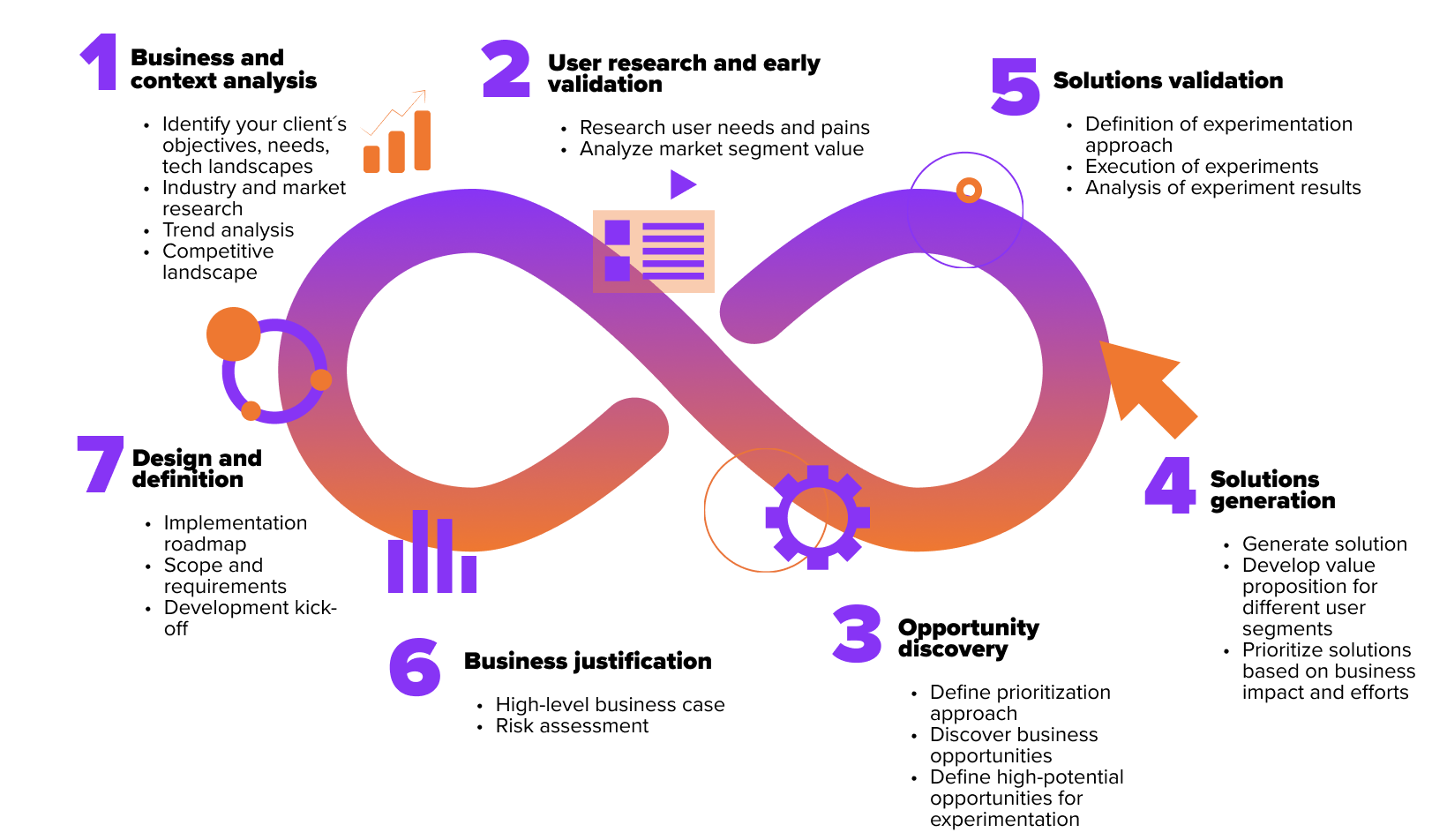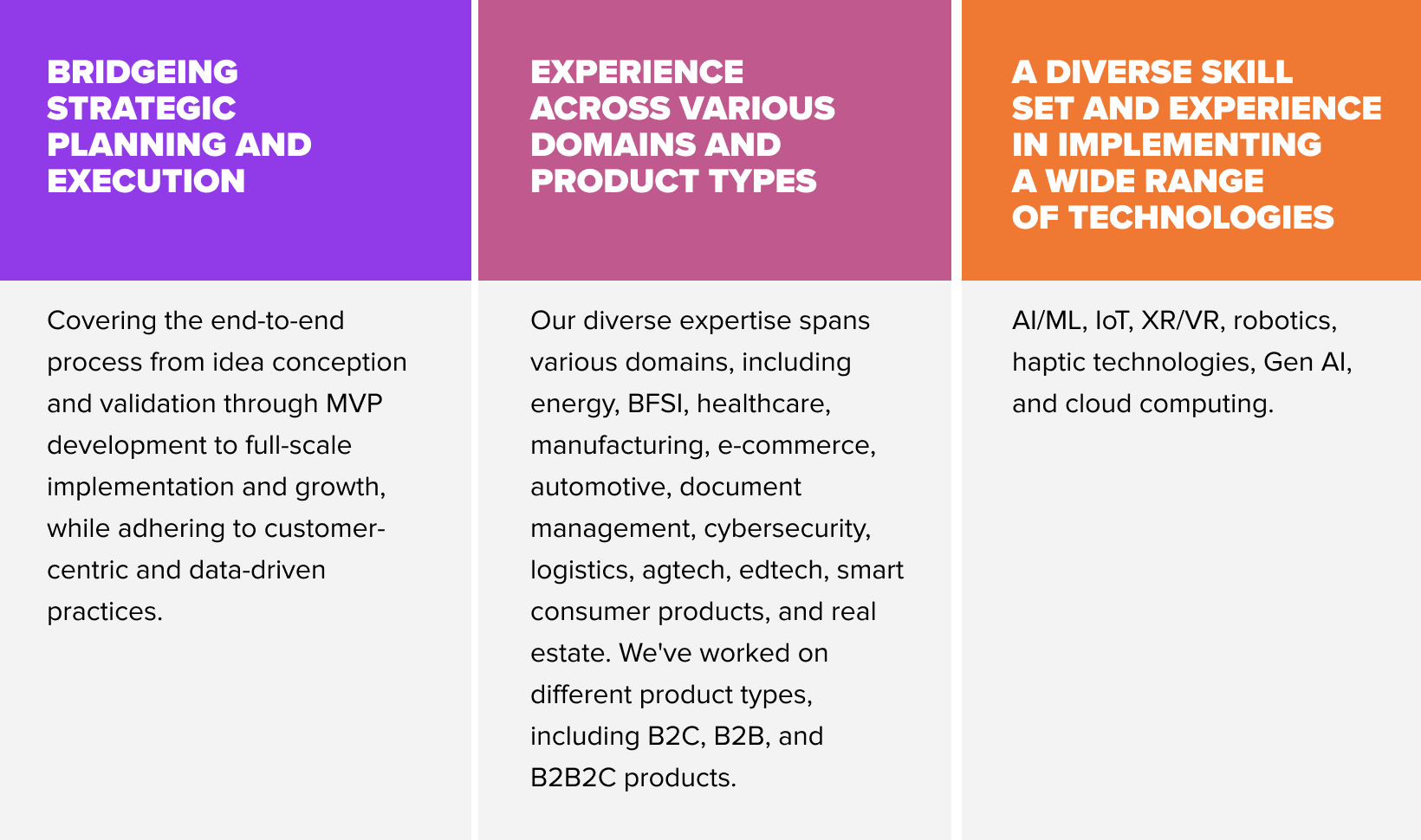In this age of advancing technologies, today’s leaders face growing challenges in maintaining a competitive edge and exploring new business opportunities. They must constantly work to enhance client-facing digital offerings and improve operational efficiencies through process automation.
But integrating tech advancements into products can be like piecing together an intricate puzzle. Digital transformation managers and business leaders often struggle with a lack of internal expertise or difficulty identifying the right use cases for emerging technologies.
Failing to address these challenges leads to a rapid loss of competitive edge. However, there are ways to streamline the effort, mitigate risks, and create confidence in future results.

This challenge involves identifying the most valuable use cases and rigorously testing assumptions before creating full-scale implementations. Properly executed, you’ll achieve impactful, sustainable, and measurable results that support your business objectives.

The following steps are helpful:
- Outline use cases.
- Review market potential.
- Check development costs and ROI.
- Think about strategic alignment.
- Identify risks and technical feasibility.
- Experiment to reduce risks.
Step 1. Define Key Use Cases
Outline the primary use cases for adopting new technologies. Focus on those areas where technology can bring significant improvements and help build lasting advantages for the organization.
Step 2. Assess Market Potential
Evaluate the market opportunities associated with the adoption of new technologies. Understand the potential impact on market share, customer acquisition and satisfaction, and overall industry competitiveness.
Step 3. Evaluate Development Costs and ROI
Evaluate new technology implementation costs and, at the same time, estimate the potential return-on-investment (ROI) to ensure it aligns with your financial goals.
Step 4. Consider Strategic Fit
Determine if these new technology opportunities fit well with what the organization wants. Be sure these technologies will help you reach your long-term goals and support business growth.
Step 5. Identify Risk and Technical Feasibility
Identify the risks that adopting new tech sometimes bring, and consider both the business and technical aspects. Evaluate technical feasibility to ensure your organization can effectively implement and integrate the tech either internally or with a trusted partner.
Step 6. Experiment to Minimize Risk
Begin by using small experiments or pilot projects to lower the risks linked to unnecessary development or low adoption. Test and confirm the results to see if product ideas satisfy the users before going all-in. By doing this early on, you can test and improve ideas, find challenges, and gather early-user feedback.

Balancing ongoing customer discovery and timely product delivery is challenging because both demands require simultaneous attention.

Recently, this challenge has gained increased relevance due to evolving customer expectations and the shift towards lean product development practices.
Achieving the right balance involves strategic prioritization and resource management, allowing you to check your customer’s pulse without causing product delivery delays . Here’s a helpful, four-step approach:

- Invest in the product mindset. Cultivating a product-centric mindset is an imperative for any organization. Mature product management is responsible for harmonizing customer-centricity with achieving strategic business outcomes.
- Pursue discovery and delivery efforts. Continuously streamlining continuous work in both areas allows for proven strategic alignment with organizational objectives, while still meeting end-users' demand.
- Incorporate effective feedback loops. Establish robust processes for gathering and analyzing feedback to inform decision-making and drive ongoing product improvements. This allows the organization to adapt and refine products based on evolving customer needs.
- Encourage a regular iterative release process. Establish a regular iterative release process to ensure the frequent delivery of value to customers, incorporating feedback loops.

This challenge arises due to the conflicting goals of reaping short-term gains and maintaining an overall strategic vision.

Immediate wins often address pressing customer needs, but may interfere with a broader, longer-term vision. To avoid compromising the overall product vision, these steps are helpful.

1. Align product strategy with organizational objectives
Developing and prioritizing product functionalities is easier when these efforts clearly match the company's business goals. This not only earns stakeholder support, but also boosts team morale and productivity by showing how the product improvements contribute to overall company success.
2. Begin with quick wins that demand minimal effort
Strategize ways to swiftly showcase the immediate benefits of digitization or automation, while keeping the broader vision in mind. Initiating smaller, manageable projects builds momentum and garners support for more extensive initiatives with higher overall impact.
3. Measure and analyze results
Establish product KPIs and monitor performance compared to what you've planned. This helps see what's working, find areas to improve, and make your product even better.
Transforming Ideas Into Adopted Products
To overcome these challenges, you need a technology team with expertise in overseeing digital products from inception through launch and continuous enhancements. This team should be guided by an experienced product manager who can build confidence in your development process.
Since this role necessitates significant cross-functional collaboration within the organization, it may seem that it should be an in-house position. However, engaging with a premier IT consulting and digital services provider can bring exceptional external perspectives. SoftServe offers tools, and expertise, coupled with the flexibility to adapt swiftly to your organization's evolving needs, ensuring seamless cooperation and successful project outcomes.
SoftServe's Experimentation and Validation Approach

The Highlights of SoftServe’s Product Management Expertise

Conclusion
Successful innovation and effective digital transformation is challenging, and often uncertain, for many organizations. Having a skilled product manager with vast experience in streamlining research and development efforts to shorten time to value is crucial for the success of any software product.
SoftServe’s approach to product management, shaped by many successful product deliveries, can be a shortcut to save time, reduce risks, and challenge the status quo.
Let’s talk about how you can embrace the value of our proven product management expertise and drive your digital initiatives to new heights.

